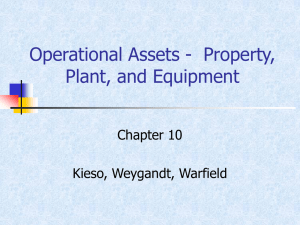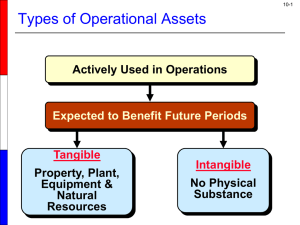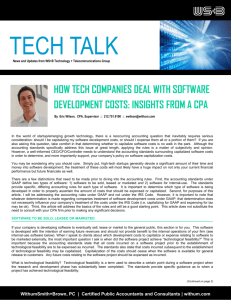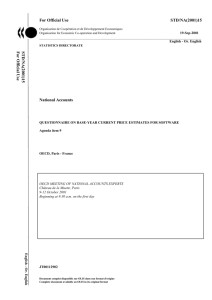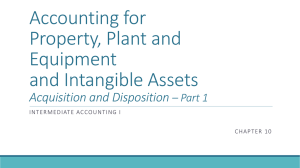Capitalization Guidelines - Finance
advertisement
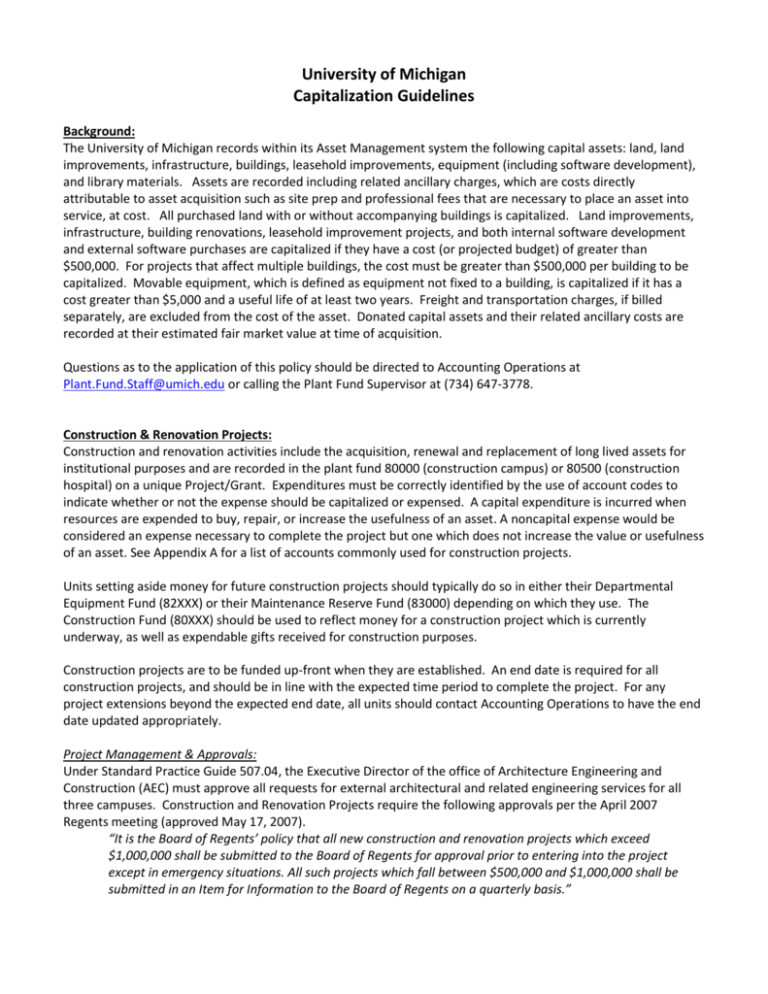
University of Michigan Capitalization Guidelines Background: The University of Michigan records within its Asset Management system the following capital assets: land, land improvements, infrastructure, buildings, leasehold improvements, equipment (including software development), and library materials. Assets are recorded including related ancillary charges, which are costs directly attributable to asset acquisition such as site prep and professional fees that are necessary to place an asset into service, at cost. All purchased land with or without accompanying buildings is capitalized. Land improvements, infrastructure, building renovations, leasehold improvement projects, and both internal software development and external software purchases are capitalized if they have a cost (or projected budget) of greater than $500,000. For projects that affect multiple buildings, the cost must be greater than $500,000 per building to be capitalized. Movable equipment, which is defined as equipment not fixed to a building, is capitalized if it has a cost greater than $5,000 and a useful life of at least two years. Freight and transportation charges, if billed separately, are excluded from the cost of the asset. Donated capital assets and their related ancillary costs are recorded at their estimated fair market value at time of acquisition. Questions as to the application of this policy should be directed to Accounting Operations at Plant.Fund.Staff@umich.edu or calling the Plant Fund Supervisor at (734) 647-3778. Construction & Renovation Projects: Construction and renovation activities include the acquisition, renewal and replacement of long lived assets for institutional purposes and are recorded in the plant fund 80000 (construction campus) or 80500 (construction hospital) on a unique Project/Grant. Expenditures must be correctly identified by the use of account codes to indicate whether or not the expense should be capitalized or expensed. A capital expenditure is incurred when resources are expended to buy, repair, or increase the usefulness of an asset. A noncapital expense would be considered an expense necessary to complete the project but one which does not increase the value or usefulness of an asset. See Appendix A for a list of accounts commonly used for construction projects. Units setting aside money for future construction projects should typically do so in either their Departmental Equipment Fund (82XXX) or their Maintenance Reserve Fund (83000) depending on which they use. The Construction Fund (80XXX) should be used to reflect money for a construction project which is currently underway, as well as expendable gifts received for construction purposes. Construction projects are to be funded up-front when they are established. An end date is required for all construction projects, and should be in line with the expected time period to complete the project. For any project extensions beyond the expected end date, all units should contact Accounting Operations to have the end date updated appropriately. Project Management & Approvals: Under Standard Practice Guide 507.04, the Executive Director of the office of Architecture Engineering and Construction (AEC) must approve all requests for external architectural and related engineering services for all three campuses. Construction and Renovation Projects require the following approvals per the April 2007 Regents meeting (approved May 17, 2007). “It is the Board of Regents’ policy that all new construction and renovation projects which exceed $1,000,000 shall be submitted to the Board of Regents for approval prior to entering into the project except in emergency situations. All such projects which fall between $500,000 and $1,000,000 shall be submitted in an Item for Information to the Board of Regents on a quarterly basis.” It is recommended that Projects $1,000,000 or greater be managed by AEC. All projects which require the use of an external architect or engineering services must be managed by AEC. Generally departments have the discretion to manage their own building projects if the above conditions do not apply. Questions regarding the proper accounting treatment for non-capital projects (repairs, cosmetic upgrades, and general maintenance) should be directed to Accounting Operations. For General Fund units on the Ann Arbor campus, the Provost's Office has developed Capital Project Guidelines to use when considering a project. The Capital Project Guidelines provide detailed information on the process of preparing and submitting a capital project request to the Office of the Provost. Land: The AEC Real Estate office is responsible for the purchase and sale of all University real estate. All expenses made to acquire land and prepare it for use are capitalized as part of the land cost through the land procurement chartfields (Fund 80000/DeptID 688150/Program 10000/Project/Grant C833160). When land has been acquired for the purpose of constructing a new building, all of the costs incurred to prepare it for that purpose are capitalized as part of the cost of the land (such as clearing, grading, and backfilling). Standard Practice Guide 601.23 relates to real estate transactions. Leasehold Improvements: A leasehold improvement is an improvement made to a leased building/infrastructure asset by a department that has the right to use this leasehold improvement over the term of the lease, and the improvement will revert to the lessor (third party or another University department) at the expiration of the lease. The AEC Real Estate office is responsible for negotiating and executing the leases entered into by the University. Financial Operations oversees the accounting for leases to ensure all transactions are recorded in accordance with US GAAP. Indicators that expenses should be considered capitalizable by the lessee as leasehold improvements include, but are not limited to: The lessee is responsible for funding the improvement and has discretion in determining how the funds will be used. The improvement is specific to the needs of the lessee, and its useful life is not expected to extend beyond the lease term. The improvement is not integrated into the leased property (e.g. an elevator or plumbing). Expenditures for leasehold improvements must be recorded in the construction funds (80000 or 80500) on a Project/Grant. Requests for a new Project/Grant can be made through the Shared Services Center (SSC) by completing a Project/Grant eform available on the SSC’s website at http://ssc.umich.edu/eForms. Leasehold improvements should not include maintenance and repairs done in the normal course of business, as these items should be expensed as incurred. Further, moveable equipment or office furniture that is not attached to the leased property is not considered a leasehold improvement. The cost of a leasehold improvement should be capitalized if greater than $500,000 and depreciated in its entirety (i.e. assume no residual value) over the shorter of (1) the remaining lease term, or (2) the estimated useful life of the improvement. If the lease contains an option to renew and the likelihood of renewal is uncertain, the leasehold improvement should be depreciated over the life of the initial lease term or estimated useful life of the improvement, whichever is shorter. Leasehold improvements made in lieu of rent obligations may require further evaluation and should be discussed directly with Financial Operations in order to determine the appropriate accounting treatment. Land Improvements/Infrastructure: Land improvements typically serve the use of a particular site or building, and include things such as pathways, parking lots, swimming pools, and fencing. Infrastructure assets are long lived capital assets that are generally stationary in nature, can be preserved for a significantly greater number of years than most capital assets, and typically serve the public or community as a whole. Examples of infrastructure assets include roads, bridges, tunnels, drainage systems, water and sewer systems, dams, and lighting systems. Equipment: Standard Practice Guide 520.1: Acquisition, Use and Disposition of Property (Exclusive of Real Property) provides guidance on the proper acquisition, management and disposal of equipment. Equipment is capitalized and depreciated if it meets all of the following criteria on a per item basis: Cost at or exceeding $5,000 Useful life of two or more years Freight and transportation charges, if billed separately, are excluded from the cost of the asset. To process equipment asset transfers, send an email to amtransfers@umich.edu. Include the asset ID, tag number, department ID it is being transferred to and reason for transfer. Currently the University uses seven account codes to categorize moveable equipment purchases; See appendix B for a list of the accounts with descriptions. Library Materials: The University has various libraries across campus and the library materials purchased for these libraries are capitalized. The account codes used to purchase library materials are only used by the Library departments within the University. In May 2007, a combo edit rule was put in place that stops the usage of a library account codes from being used on a Department ID that is not one of the Library Departments within the University. There currently is no threshold for library material purchases, all items are deemed capital. The six account codes used to categorize library materials are referenced in Appendix C. Other Capital Asset Issues: Asbestos –If asbestos removal is the sole purpose of a stand-alone project, it must meet the cost criteria of $500,000 per project in order to be capitalized. If AEC designates another funding source for the asbestos charges on what is considered a capital project, and then subsequently transfers those costs to a different project, the costs associated with the asbestos removal will be capitalized. Environmental Issues (i.e. Underground Tanks) – AEC projects that deal with environmental issues (such as soil remediation) are capitalized if they exceed the cost criteria of $500,000. These projects are typically capitalized under the land improvement category. Repairs & Maintenance costs – If repair or maintenance costs lengthen or add additional functionality/safety not currently included then the costs can be capitalized if greater than the $500,000 threshold. If the costs ultimately are to put the asset back in a state of normal or expected operations then the costs are considered non-capital in nature and expensed as incurred. Furnishings – Furnishings are excluded from capitalization and should be expensed at the furniture account code 610875. Programming – Programming work that does not lead into a construction project should not be capitalized. Programming is defined as a statement prepared for an owner, with or without an architect’s assistance, setting forth the conditions and objectives for a building project including its general purpose and detailed requirements, such as a complete listing of the rooms required, their sizes, special facilities, etc. Hosting and Travel Charges – Hosting and travel charges might be appropriate for various projects; however, they should not be capitalized. Capitalized Interest –Interest costs incurred during the construction period (which is defined as the time from the debt being borrowed up until the date the project is determined to be substantially complete) that result from the borrowing of external debt of $20M or more per project are capitalized. Demolition Costs – Demolition costs should be capitalized as building costs if the demolition was necessary in order to construct/renovate a facility. Demolition costs that are incurred to leave land vacant should be capitalized under the land improvement category. Federally Funded Construction Projects – Construction projects that receive federal funding are handled in the same fashion as any other University funded project. Pre-Purchased Light Fixtures – Stand-alone projects created for pre-purchased light fixtures are capitalized as infrastructure if they exceed the cost criteria of $500,000. Capital Outlay Appropriations (SBA Projects): Capital Outlay Appropriations are funds received from the State of Michigan to assist with funding a capital project on campus. The University will provide the State Building Authority (SBA) at the State of Michigan project requests asking the State to provide monetary assistance with a proposed capital project at the University. The projects could be on any of the three University campuses. The State Budget Office reviews the capital outlay requests, and if approved, includes the request in a planning authorization bill or legislative initiative. If approved the University is required to perform certain tasks laid out in the State of Michigan – Capital Outlay Manual to ensure funding from the State in the future. The University is required to incur a certain level of costs up-front before submitting reimbursement requests to the State based on the project budget and approved Capital Outlay Appropriations. Each project has its own specific spending outline. Guidelines Related to Purchased and Internally Developed Software Purchased Software: Software will be capitalized whenever it is purchased at the appropriate account code depending on cost. Costs less than $500,000 – should be expensed using account 612100 (Computer Software), which is used to record costs of computer software, computer licenses, and mobile applications. Cost greater than or equal to $500,000 – should be expensed using account 614050 (Software > $500,000). These costs will be capitalized. Internally Developed Software: In general, internally developed software is considered to be capitalizable when the end product clearly adds future value to the organization for at least two years and the costs to develop exceed $500,000. A change to an existing IT system is considered capitalizable when the changes enhance the functionality of the product, including a situation where current software is replaced with a new release or upgraded programing language. Software maintenance should be treated as part of normal operations, and expensed as incurred at the appropriate account code. Hardware components should follow the equipment capitalization policy. Below are tables illustrating costs that are capitalizable and non-capitalizable: Capitalizable Costs and Examples Capitalizable Costs External direct costs of materials Payroll & payroll related costs for employees working directly on the project (including coding, testing and software setup) Upgrades and enhancements that increase functionality of existing internal-use software, including major revisions of third party products Data conversion System hardware Examples Costs of producing product masters Salaries Benefits (exclude meals, alcohol, and morale related expenses) Cost of software upgrade resulting in additional functionality Installation costs as described for new software Costs to develop or obtain software that allows for access or conversion of old data by new systems Capitalize separately as equipment Non-Capitalizable Costs and Examples Non-Capitalizable Costs (Expense) Research and development Examples Conceptual formulation of alternatives, Determination of existence of needed technology, final selection of alternatives Evaluation of alternatives Training costs General and administrative costs Implementation costs Data conversion costs Decision whether to develop a new system or to correct problems of existing system Functions to be performed by software End-user training salaries Materials Space Utilities Overhead costs Supplies Equipment (desktop support) Support staff salaries (non–dedicated) Customer support efforts Help desk Internal and external training Maintenance costs Purging / cleaning existing data Reconciliation / balancing of old data and data in the new system Internal costs External costs incurred under agreements related to specific upgrades and enhancements that do not increase functionality, i.e., those costs which merely extend the useful life are considered maintenance activities Portion of software contracts attributable to maintenance contracts Upgrades & enhancements Maintenance Purchased or leased computer software used in research & development (R&D) Direct expenses Correction of errors Minor updates to keep software current Unspecified upgrades Phases of Computer Software Development as Relates to Capitalization: There are instances when the University of Michigan decides to replace or upgrade existing technology, which may include purchasing or developing software to fit the needs of specific users. In connection with this process, the University of Michigan ensures that the activities generally fall under the guidelines of GASB Statement No. 51: Accounting and Financial Reporting for Intangible Assets (GASB 51). Computer software development generally has three main stages, which are outlined below. Only costs included in the Application Development Stage (section 2 below) are able to be capitalized. Costs to be capitalized would begin when the project is approved and would end when testing is complete and the software is ready to be used. If it is determined that the project will not be completed the costs should be expensed. Below are the three stages of development. 1. Preliminary Project Stage (not capitalizable) For research and development of internal-use software o Conceptual formulation of alternatives o Evaluation of alternatives o Determination of existence of needed technology o Final selection of alternatives 2. Application Development Stage (capitalizable) Project has been approved, funding sources identified, and stage one is complete o Design of selected software, including software configuration and software interface o Coding o Installation of software o Quality assurance testing 3. Post-Implementation / Operation Stage (not capitalizable) All testing is substantially completed and software is ready for intended use o Data conversion costs o Training o Application maintenance (over the maintenance period) o General & administrative costs o Overhead allocation Questions concerning the application of GASB 51 to internal software development costs incurred by the University should be directed to Financial Operations. Appendix A (Construction Account Codes) A limited number of capital and noncapital expenditure accounts are available for use. The following accounts are most commonly used: Capital Noncapital 610000 (Bldgs - General Contracts) 610775 (Plant Noncapital Items) 610450 (Bldgs - Fees) 610875 (Furniture - Noncapital) 610600 (Bldgs - Umtel Charges) 610885 (Noncapital ITCom Charges) 621450 (Rebilled - Natural Gas) 610890 (Noncapital Fees) 621540 (Rebilled - Water & Sewer) 614000 (Equipment) 621630 (Rebilled - Electricity) 614210 (Equip - Upgrade Existing Equip) 622230 (CPP - Steam Distribution) 614390 (Computers - Under $5,000) 622290 (CPP - Electric Distribution) 622320 (N Campus - Electric Dist) A complete list of valid accounts in the Construction funds is available via the Valid Account Listing on the Financial Operations website. Appendix B (Equipment Account Codes) 614000 – Equipment: Account used to track equipment purchases $5,000 and over with a useful life of at least two years. 614030 – Equipment Cost Distribution: Account used to track equipment purchases when two or more sets of chartfields share the cost of the purchase. The chartfields contributing the greatest share towards the purchase price of the equipment is charged for the entire cost of the asset at an equipment account other than 614030, usually account 614000. The same chartfields are credited at 614030 for the amount of all other contributions by all other chartfields. The other chartfields are debited at 614030 to record their share of the cost of the purchase. If there is a Federal Project/Grant involved the entire cost must be charged to the Federal Grant and cost shared from there. 614020 – Prefabricated Structures: Account to track the expenses for prefabricated structures. 614050 – Software > $500,000: Account to track purchases of software greater than $500,000. If software is developed internally the costs should be recorded in the fund 81000 (Construction – Info Tech) or 81500 (Construction – Hospital IT) using the proper accounts for capital versus non-capital. Further discussion on internally developed software is provided in a separate document. 614060 – Equipment Component: Account used to track expenses for a fabrication when the estimated non-labor cost will exceed $5,000. A separate set of chartfields is established to accumulate all non-labor costs for eventual capitalization to the one line item on the equipment inventory. This is currently only used for Sponsored Projects. 614210 – Equip – Upgrade Existing Equip: Account to track expenses related to components or modifications that increase the value of existing equipment by changing its performance capabilities. The minimum threshold for using this account is $2,000. 614240 – Equip – Federal Accountability: Account used for equipment whose title may revert under some named condition to an outside sponsor, usually a federal agency. Appendix C (Library Account Codes) 615575 – Interlibrary Loans: Non-capital account used to track books on loan from other libraries. 615580 – Single Use Access Databases: Non-capital account used when the library has access to a database of information for a limited amount of time. 615585 – Perpetual Databases: Capital account used to track expenses for online access to information that in the past would have been in hard copy print. 615590 – Library Books: Capital account used to track actual book purchases for the libraries. 615593 – Bibliographic Records: Capital account used to record bibliographic records and authority records that are used by the University Library to track and catalog orders (books and equivalents) to provide access to the collection for patrons. 615595 – Bookbinding for Library Books: Capital account to track the rebinding of a hard copy book, which makes the book like new again.
